In the early 2010s, passive emitter rear cell (PERC) technology, as a high-efficiency cell technology at the time, quickly replaced the conventional back surface field (BSF) cell technology to dominate the solar cell industry until today.
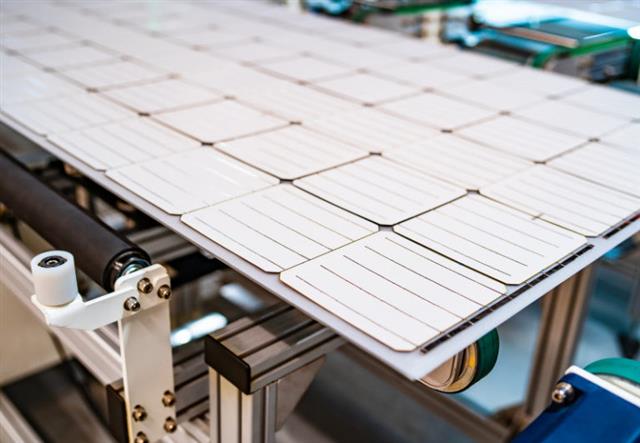
According to the data released by China Photovoltaic Industry Association (CPIA), PERC cells took 91.2% market share in 2021, remaining at the top.
The rise of PERC
Dr. Martin Green and his team at the University of New South Wales developed PERC technology in 1983. Then six years later in 1989, the first paper describing the architecture of PERC cells was published, which was normally regarded as the start of the development of the technology.
However, it was not until 2013, over 20 years later, did the technology gain sufficient ground for mass production and commercialization.
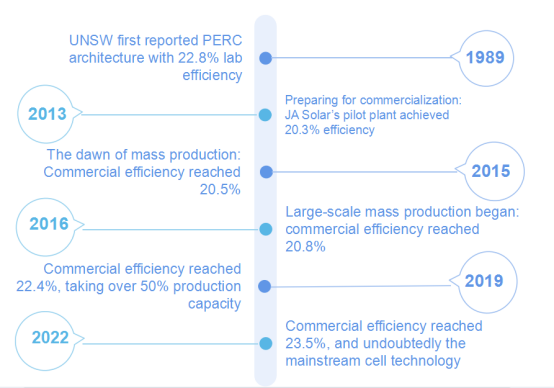
Large-scale mass production began in 2015. Four years later in 2019, manufacturers sped up the commercialization process, so that the production capacity for PERC cells surpassed that for BSF cells for the first time in history.
Architecture and process of PERC cells
PERC has been updated from the conventional BSF cells. It is aimed to achieve higher conversion efficiency by adding a dielectric passivation layer on the rear of the cell. The passivation layer can contribute to the increase of efficiency by reducing electron recombination.
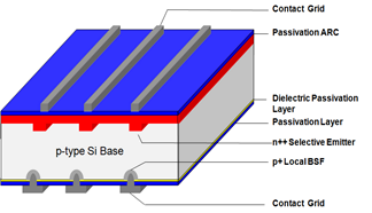
The structure of a PERC solar cell
The manufacturing process for PERC cells are relatively simple with established equipment.
The major processes include the deposition of the passivation layer on the rear side of the cell and laser etching to open small pockets in the passivation layer.
In recent years, new processes have been introduced to further improve the cell’s efficiency, such as laser doping selective emitter (LDSE), alkaline polishing, and electrical injection method.
Rising efficiency
PERC is inclusive and compatible with different kinds of cell technologies and even wafer technologies, which makes it easier to improve its efficiency.
Since it has been invented, PERC cell’s commercial efficiency has been climbing from about 20% to about 23.5% now. It is estimated that the commercial efficiency of PERC cells can reach about 24% in the next three years.
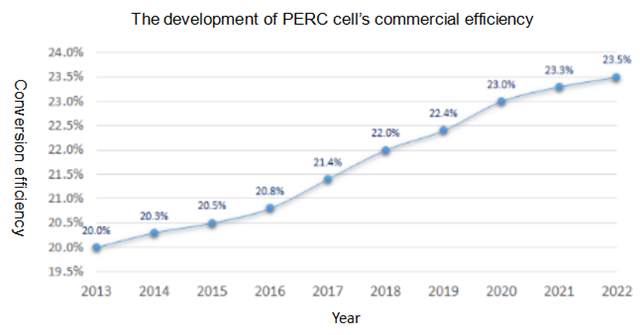
In the past decade, the path to improve the efficiency of PERC cells has been mainly focused on higher light absorption and lower electron recombination.
a. Optimized busbars: since the advent of solar cells, reducing the busbars that partially block the sunlight and improving the collection efficiency of currents have been the major directions for efficiency improvement. The most common methods include increasing the number of busbars, adopting multi-busbars (MBB), adjusting the busbar’s dimensions and using the dual print process, etc.
b. Bifacial technology: PERC cell boasts higher bifaciality. Designed with special structure and finger contact, bifacial PERC cells can absorb more sunlight and produce much power from both sides.
c. Selective emitter: Selective emitter solar cells are characterized by localized regions of heavy doping underneath the metal contacts. This effectively decouples the requirement of heavy diffusion in the vicinity of the contacts, and light diffusion in the light-incident surfaces.
d. Solution for light induced degradation (LID): Gallium-doped PERC cells can suppress the boron-oxygen-related LID.
Byungsul Min and other researchers from the Institute for Solar Energy Research in Hamelin (ISFH) analyzed different technical routes to optimize PERC cells, and found that the commercial efficiency of PERC cells can get over 24%.
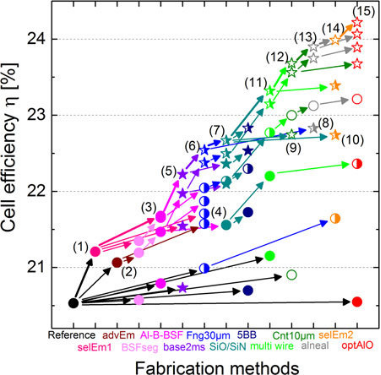
Source:B Min, M Müller , H Wagner, A Roadmap Toward 24% Efficient PERC Solar Cells in Industrial Mass Production, IEEE Journal of Photovoltaics , 2017 , PP (99) :1-10
PERC will continue to dominate the market in the next 3 years
With its cost-effectiveness and high production capacity, PERC is likely to remain the mainstream technology in the next three years. Manufacturers will continue their efforts to improve its efficiency and lower its cost.
According to CPIA, PERC will still take over 50% market share in 2025.
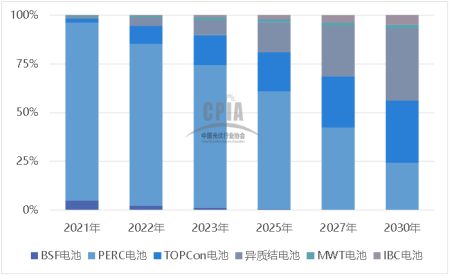
The market share of different cell technologies 2021-2030(E)
The iteration of technology is the driving force for the healthy and stable development of the solar industry.
CPIA projected that the share of n-type cells, especially TOPCon cells and heterojunction (HJT) cells, will increase year by year due to their potential for higher efficiency. However, both technologies will require newly built or renovated production lines, which means higher costs.
Compared with the cost of PERC cell production line of 150-200 million yuan/GW, the cost of a new production line for TOPCon is about 30% higher. Even if only renovation is required on top of the existing PERC production line, it will still involve 20% higher cost.
The cost of HJT cell production line is even higher, which is more than twice that of the PERC production line.
In view of the high costs, the expansion of n-type technology will be much slower than PERC’s replacement for BSF cells.
In 2021, the market share of n-type technology was only 3%. It is estimated that by 2025, the market share of TOPCon and HJT cells will only reach about 40%.
In addition to the cost, n-type technology needs to be verified through applications in order to pick up the baton in the future. Until then, PERC will remain the protagonist of the solar industry.


